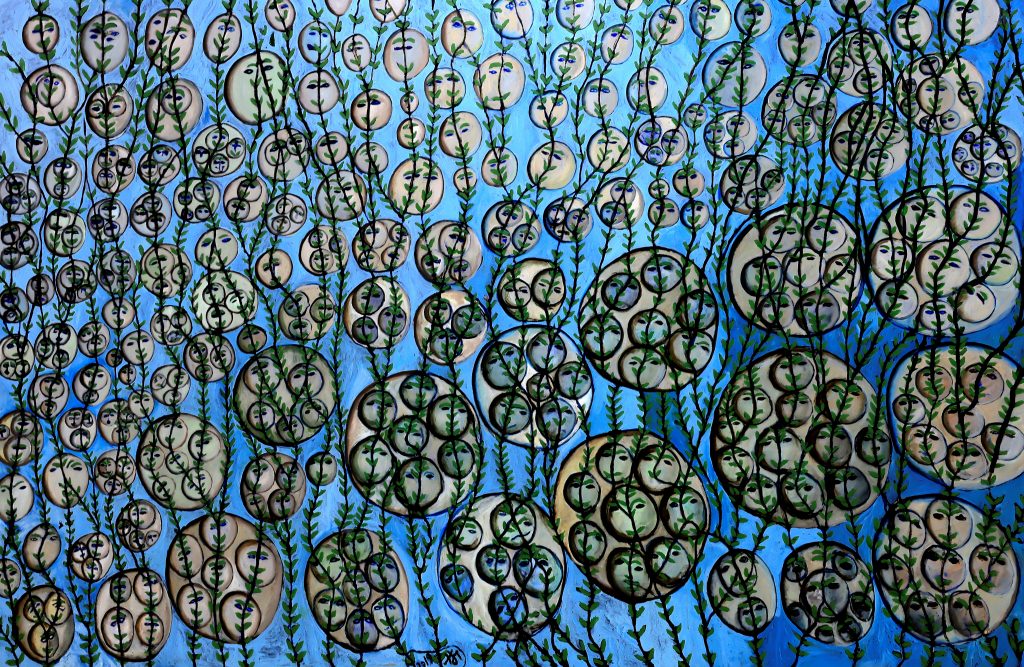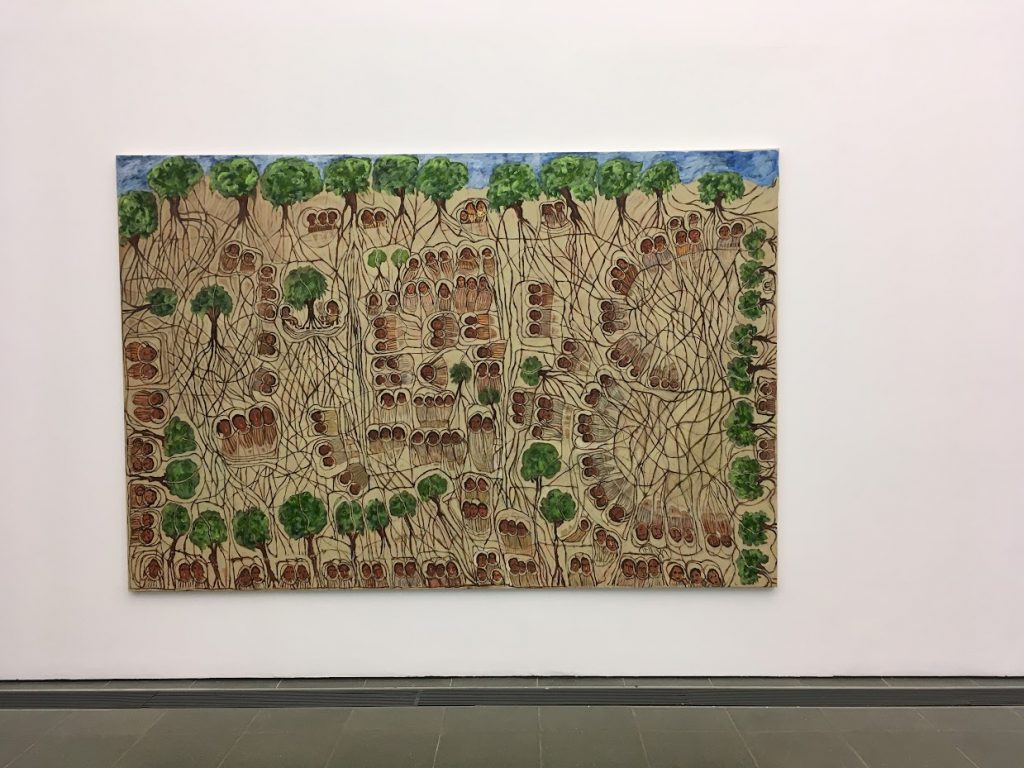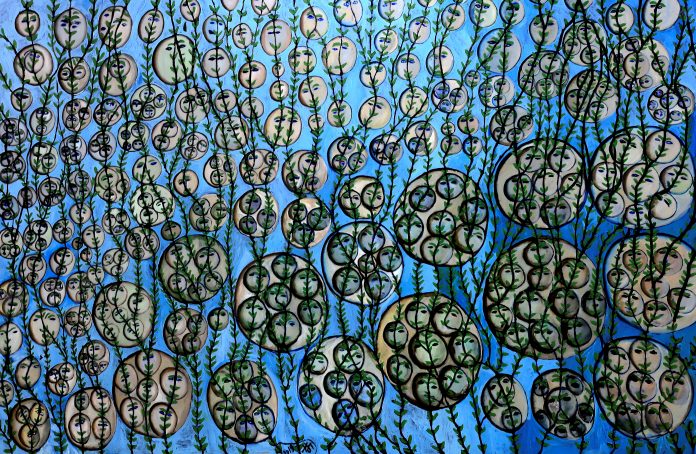The Serpentine’s small size betrays the depth of its curation. Its two current exhibitions are no exception, two great celebrations of international female artists – Kamala Ibrahim Ishag, and Barbara Chase-Riboud.
‘The two dimensional drawing is a poor and insignificant form of creative expression,’ says the Sudanese artist Kamala Ibrahim Ishag. States of Oneness encourages us to embrace the third, fourth and more dimensions – both in medium, and mentality.
Whilst studying in London’s Royal College of Art (RCA) in the 1960s, Ishag encountered William Blake’s visionary subjects, Francis Bacon’s distorted figures, foreshadowed by surrealism, and perhaps too the screaming faces of Edvard Munch. Glamorous photographs of the artist in Khartoum contrast with her new explorations of isolation in the city – fearful faces distorted by the curved windows of the London Underground, seen during her daily commute.
Throughout the exhibition, we get the sense of an artist incredibly engaged with her surroundings. In Sudan, Ishag was a leading figure in the Khartoum School, which played a key role in the country’s achievement of independence from British and Egyptian rule in 1956. She then led its opposite Crystalist Group, a conceptual movement that challenged traditional practices in the 1970s and 1980s.
Crystalism was part of Ishag’s attempt to ‘contribute to intellectual discourse’, cemented in her artist statement – or manifesto – in the third Sudanese Cultural Festival in 1980. States of Oneness stashes heaps of archive material, highlighting her interdisciplinary practice.
Ishag returned to Britain for postgraduate study in 1968, undertaking another RCA course in book illustration (and muralism, on the side). But she always applies these practices to Sudanese subjects. Mahmoud Mohamed Taha, the leader of the Republican Brotherhood, comments in her 1974 solo exhibition at the Sudan National Museum. Beneath him, another visitor proclaims, ‘Amazing! I wish you were my life partner’.

It is this political commitment to reform that persists through to her most recent work, a homage to the hundreds killed and drowned in the Khartoum Massacre of 2019. What began as a peaceful, pro-democracy protest following the deposition of President Al-Bashir. Isolation here comes in bubbles which still, hopefully, grow out in trees.
Of course, Ishag ‘refuses to be confined’ to a single movement or style. (Her miniatures, on show, were painted in response to critics who presumed she would only paint on a large scale.) Here – as in her interviews – we get a sense of the artist’s joy and humour, her love for art.
It’s evident too in her experimental approach, painting on everything from leather drums, pots and partitions, to calabash gourds. The artist considers these not as sculptures but paintings, their natural distortions reflecting human ones, in paintings such as ‘Composition’ (2016) and ‘Partition’ (1973/2016).
Ishag is arguably even more visionary than her influences. Some of her best and earliest works are those on a diagonal, highlighting her perspectives from a ‘different axis’, an ‘alternative realm of consciousness’. Plants play a great role in her practice from the 1970s, and particularly 1990s onwards. ‘I believe that plants and humans are one and the same’, she remarks in a video, showing how her house was constructed around two trees, which continue to guard her family.
‘Bait Al-Mal’ (2019) likewise pays tribute to the landscape and relationships of her childhood neighbourhood, its roots entangled with her own family tree, and stories passed on by her mother. This mutual respect for family and nature also adorns manuscripts of the Quran, written by her great-grandfather.

Ishag also uses these Blakean aspects to show Sudanese ritual and spirituality. The first room is devoted to Zar, a women-led healing ceremony, where we see women in states of trance, together. Despite its name, States of Oneness is characterised by plurality; of women, not woman, and the many aspects of an individual’s personality.
For all its women subjects, the artist rejects the designation of her art as ‘feminist’, along with the very possibility of assigning male or female art. Though her Crystalline works tend towards trapped women, her Manifesto speaks more widely to collective isolation, impacting men and women in society.
‘For people to feel each other, that’s also an art’, she says. Art, like nature, is something intrinsic, ‘part of every human being’. States of Oneness embodies Ishag’s total approach to art; and her bid to connect us with our environments and each other.
Free entry aside, the Serpentine is incredibly accessible, and makes full use of the app Bloomberg Connects (BC) to supplement the range of media on display. Paper guides are still available – mine treasured as souvenirs – but this enables us to see and hear from the artists and curators themselves.
Both exhibitions employ the app differently. States of Oneness almost entirely cuts out text from its walls, but Infinite Folds (from Barbara Chase-Riboud), the app adds the curators’ perspectives to the works on display. The former makes for a clearer, less overwhelming experience within the space.
Finding a path around both shows can be confusing, in part due to conflicting directions from the guide maps, and the app. (In States of Oneness, a spiral works well, in Infinite Folds, take a reverse scharfes S.) Perhaps its an assumption, that viewers might already know their way around.
It may be better to leave out directions altogether, so as not to impose an order or overwhelm viewers with information within the space. Still, both remain on the app in perpetuity, serving as an archive and enabling access to the works beyond their exhibitions’ space and time.
Kamala Ibrahim Ishag: States of Oneness is on view at the Serpentine South Gallery until 29 January 2023.
For more on Barbara Chase-Riboud: Infinite Folds, on view at the Serpentine North Gallery until 29 January 2023, read Jelena’s profile in gowithYamo.
Words by Jelena Sofronijevic
Support The Indiependent
We’re trying to raise £200 a month to help cover our operational costs. This includes our ‘Writer of the Month’ awards, where we recognise the amazing work produced by our contributor team. If you’ve enjoyed reading our site, we’d really appreciate it if you could donate to The Indiependent. Whether you can give £1 or £10, you’d be making a huge difference to our small team.
